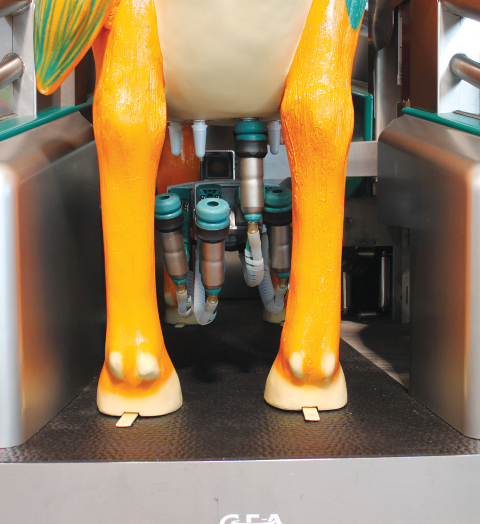Robots and Rotaries

written by Wilfried Wesselink
Equipment companies inch toward commercialization
With labor costs and issues still a huge problem worldwide,
|
| More on GEA and DeLaval robotic rotaries |
milking equipment companies continue to push forward with automated milking solutions for dairy operations large and small.
During the EuroTier show in Hanover, Germany, this past November, GEA showed a prototype of its DairyProQ robotic milking stall module. Installed in a 32-stall rotary, it will be capable of milking 400 to 500 cows profitably, the company says.
GEA officials note that the DairyProQ is designed for flexibility, capable of milking on outside rotaries and in herringbone and side-by-side parlors.
The module is designed for either semi-automatic milking or complete automation of the entire milking process.
For semi-automatic milking, attachment of teat cups would still be done by human hands. But teat sanitation, unit removal, sanitation of the milker units and postmilking teat dipping would be done automatically. Full automation would include teat cup attachment. Even then, GEA assumes that one person will be needed in the parlor to monitor the operation and/or bring cows to the parlor.
Full automation would include teat cup |
The prototype has a robot for each stall. That allows for quick reattachment of a teat cup should it be kicked off. The robot arm and teat cups are located beside the cow, tucked away and hidden for protection between the sides of each stall. The cow is indexed into position by a sliding trough.
The robot locates the teats by a "time of flight" camera that does not require the use of historically known teat coordinates of each cow. After the teat cup is connected, the teat is washed and the initial three releases of foremilk are taken away.
During milking, the robot arm remains under the cow. Milking is done by quarter. If one quarter is done before the others, the teat cup remains attached at a lower vacuum until all four quarters are milked. Teats are then postdipped, and all four quarter units are removed.
The 32 robotic milkers are controlled by central computer. GEA is also introducing new software, called DairyProView, to monitor the milking process of all individual cows on a central display.
 |
Teat cup attachment should take no longer than 25 seconds to help achieve needed turns per hour. |
DairyProView, in turn, is linked to GEA’s Dairy Management System 21and CowView software. For CowView, each cow wears a transponder that tracks individual activity. The software logs time spent in the freestall, at the bunk and in alleys, along with distances covered.
The information gathered can then be used to assess cow health and estrus. Information can be read by computer, tablet or smartphone.
GEA has not disclosed the purchase price of the DairyProQ system. It hopes to have a prototype installed and operating on a farm by the end of this year.
Delaval's 24-stall rotary
DeLaval is currently testing four rotaries equipped with robotic milkers. Two of the rotaries are in Australia, and two are in Sweden. DeLaval hopes to have its first North American installation in the first half of 2014, says Christian Poggensee, regional president for North America.
"The challenge isn’t so much the technology. But we need to learn how to merge the concept of automated milking with the rotary parlor," he says.
DeLaval’s prototype uses just two robotic arms to attach milker units. These arms, along with two other robots used for premilking teat sanitation, are located on the inside of the rotary circle.
DeLaval has also sold its first commercial automated milking rotary to a farm in Germany, the company announced at this past fall’s EuroTier. No terms were disclosed.
—Wilfried Wesselink and Jim Dickrell







